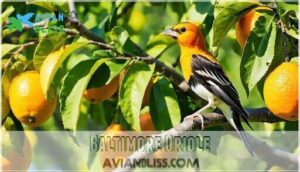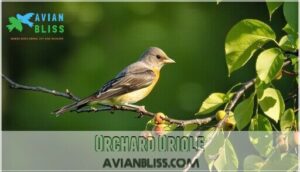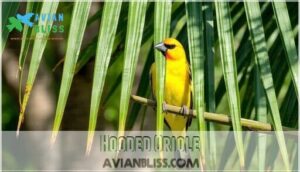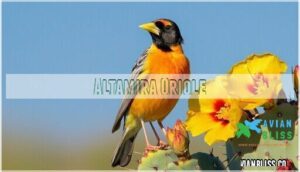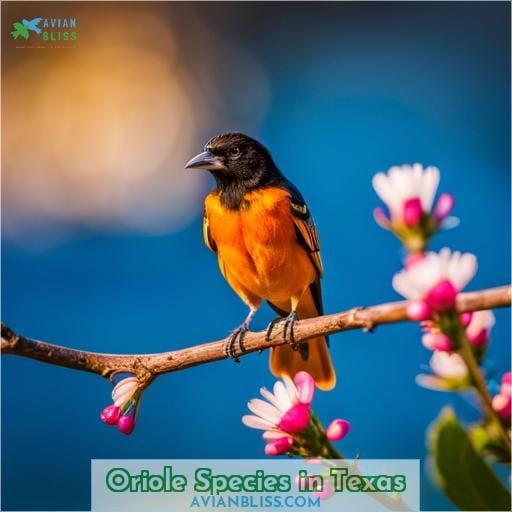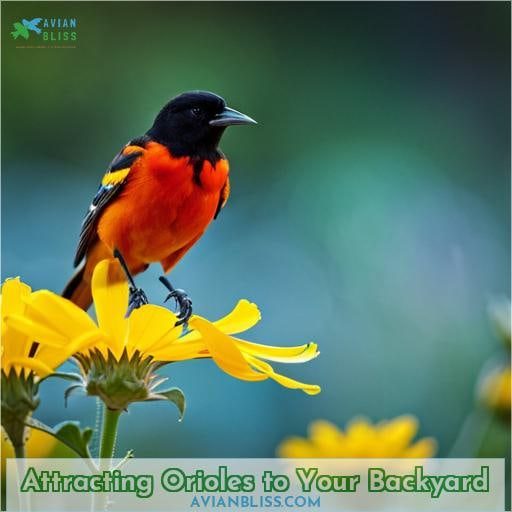This site is supported by our readers. We may earn a commission, at no cost to you, if you purchase through links.
 Amidst the rugged expanse of Texas, where open skies stretch endlessly and nature’s tapestry thrives, a symphony of colors and melodies emerges—orioles in Texas, a testament to nature’s artistry.
Amidst the rugged expanse of Texas, where open skies stretch endlessly and nature’s tapestry thrives, a symphony of colors and melodies emerges—orioles in Texas, a testament to nature’s artistry.
These vibrant avian wonders, with their distinctive hues and enchanting songs, adorn the Lone Star State’s diverse landscapes. Prepare to delve into the fascinating world of these winged inhabitants as we unveil their stories, habits, and the secrets to welcoming them into your own backyard.
Unlocking the treasures of orioles in Texas reveals a tapestry of species that grace the Texan skies with their elegance. From the familiar Baltimore Oriole with its melodious trill, to the Altamira Oriole’s resplendent glow that paints the landscape, these birds encapsulate the profound beauty of Texas’ avian tapestry.
In this exploration, we’ll journey through their habitats, migration patterns, and the delicate interplay between their presence and your desire to connect with the natural world. Join us in an odyssey that intertwines scientific inquiry with a deep-rooted desire for intimacy, offering a glimpse into the lives of these captivating creatures and how you can forge a connection, making your backyard a haven for the splendid orioles of Texas.
Table Of Contents
- Key Takeaways
- The Orioles of Texas
- Baltimore Oriole
- Orchard Oriole
- Bullock’s Oriole
- Hooded Oriole
- Scott’s Oriole
- Audubon’s Oriole
- Altamira Oriole
- Oriole Species in Texas
- Attracting Orioles to Your Backyard
- Frequently Asked Questions (FAQs)
- Are orioles in Texas known for any specific vocalizations or calls that birdwatchers can identify?**
- How does the migration pattern of Altamira Orioles differ from other oriole species in Texas?**
- What specific challenges do Hooded Orioles face during their migration between the Southern US and Mexico?**
- Are there any particular conservation efforts in place to support the breeding populations of Bullock’s Orioles in the western regions of Texas?**
- Could you provide more details about the unique nesting habits of Scott’s Oriole that set it apart from other oriole species in Texas?**
- Conclusion
Key Takeaways
- Orioles in Texas bring a vibrant symphony of colors and melodies.
- Texas is home to a diverse range of oriole species with unique characteristics.
- Orioles communicate through melodic calls, showcasing their breeding behavior and territories.
- Conservation efforts are focused on preserving habitats, sustaining migratory corridors, and monitoring populations.
The Orioles of Texas
Explore the vibrant world of orioles thriving within Texas’ diverse landscapes, igniting a captivating spectacle for avid nature lovers. The behavior patterns of these magnificent birds offer a unique insight into their lives.
From the Baltimore Oriole’s migration trends spanning the eastern US and Canada to the Hooded Oriole’s palm-leaf nests in southern regions, the orioles’ adaptability is awe-inspiring.
Texas’ varied habitats, from open woodlands to tropical zones, provide the backdrop for these enchanting creatures. Among the treasures enhancing oriole watching, the Oriolefest Feeder stands out. With its irresistible allure of nectar, oranges, and jelly, it beckons these colorful visitors while safeguarding the treats from unwanted guests.
Orchard Orioles, with their striking burnt orange hues, and the Bullock’s Oriole’s yellowish orange with unique behaviors further enrich Texas’ avian diversity. Engage in the intimate dance of observing these birds, as they reveal their freedom of flight and intricate behaviors in the enchanting world of Texas’ orioles.
Baltimore Oriole
Exploring the Baltimore Oriole’s presence in Texas reveals a fascinating range map that includes its migration from the eastern US and Canada. These vibrant birds thrive on a diet of ripe fruit and nectar, making backyard sightings a delightful possibility.
To attract these stunning creatures, providing a mix of jelly, oranges, and nectar in specialized feeders proves to be an effective and rewarding strategy.
Range Map
Discover the geographical distribution of these vibrant birds with a glance at the range map.
- Migration patterns: Orioles travel extensively, with distinct routes influenced by eastern bird habitats.
- Unique nesting behaviors: Orioles’ nests range from palm leaves to intricate designs.
- Orioles’ song identification: Learn their melodious calls for accurate identification.
- Climate impact on oriole populations: Changing weather affects their habitat and numbers.
- Bird feeders: Attract orioles by providing nectar, jelly, and fruit.
Diet: Ripe Fruit and Nectar
Immerse yourself in the world of these vibrant birds by learning about their dietary preferences – indulging in ripe fruit and nectar plays a vital role in attracting them to your garden. The Baltimore Oriole’s feeding strategies include savoring ripe fruit and nectar, contributing to their exquisite plumage variation.
Their seasonal migration patterns coincide with their feeding habits, making the availability of these food sources crucial during their journeys.
Orioles’ vocal communication, through melodious bird songs, further enhances their allure, allowing them to convey breeding behavior and establish territorial boundaries. This intricate web of feeding, migration, and communication showcases the intimate connection between orioles and their Texas habitat.
Sightings in Backyards
Witness how these vibrant birds light up your backyard as they make delightful appearances, enhancing your connection with the beauty of nature. Backyard observations reveal orioles’ feeder preferences, behavioral interactions, and seasonal movements.
Their vocalization patterns may include the distinct calls of the Scott’s Oriole and the Altamira Oriole. By providing enticing backyard foods, you can attract these captivating creatures and experience the intimate freedom of observing them up close.
Strategies for Attracting Baltimore Orioles
Explore effective techniques for luring these vibrant feathered visitors into your backyard haven and creating an enchanting atmosphere that keeps them coming back for more:
Baltimore Oriole Feed Preferences: Offer grape jelly and sugar water to cater to their sweet tooth.
Garden Enhancements: Plant orange-friendly flora like trumpet vines and fruit trees.
Nectar Feeder Options: Use oriole-specific feeders for easy access to nectar.
Oriole Behavior Observations: Watch for their distinct behaviors, like swinging on branches.
Witness Audubon’s Orioles and others indulge in nectar-filled delights, orange halves, and grape jelly. Transform your space into an alluring haven where these majestic creatures grace you with their presence.
Orchard Oriole
Delve into the characteristics of the Orchard Oriole, a vibrant bird species with a deep burnt orange plumage and a penchant for varied diets. This charming avian resident of Texas boasts a distinct presence in woodlands and forest edges across the eastern United States.
With an alluring mix of insects and nectar in its diet, the Orchard Oriole graces these habitats with its melodic calls and graceful flights.
Orioles’ nesting preferences are equally intriguing. They seek out well-hidden locations for their nests, often selecting trees that provide ample cover. The Oriolefest Feeder, a creative creation by Birds Choice, presents an opportunity to observe these intricate behaviors up close.
This innovative feeder not only offers a trio of enticing treats—nectar, oranges, and jelly—but also safeguards the feast from unwanted guests with built-in bee guards and an ant moat.
As part of their migration patterns, Orchard Orioles travel from their wintering grounds in Central America to grace Texas with their vibrant presence during the summer. Their distinctive behaviors and striking plumage make them a prized sight for bird enthusiasts, especially in regions like far South Texas and far West Texas.
Amidst the diverse tapestry of Texas birds, the Orchard Oriole stands out as a symbol of intimacy with nature and the boundless freedom of the skies.
Bullock’s Oriole
Immerse yourself in the captivating world of Bullock’s Oriole, a bird whose yellowish-orange plumage adorned with distinctive black markings brings a touch of vibrant elegance to open woodlands and western habitats.
As September approaches, this member of the blackbird family stands out not only for its appearance but also for its intriguing behavior.
Delight in the diverse Texas oriole population, where Bullock’s Orioles coexist with their fellow avian companions. Observing their migration patterns reveals their remarkable journey across different landscapes.
Consider the Oriolefest Feeder’s features, a beacon of sustenance for these elegant creatures with a sweet tooth for nectar.
As part of ongoing conservation efforts, organizations like the Cornell Lab of Ornithology monitor their movements and habitats to ensure their well-being. San Antonio’s enchanting wilderness can be your gateway to encountering Bullock’s Orioles.
They symbolize the freedom of the skies and embody the shared desire for intimacy with nature.
Cherish the moments spent observing these charming birds as they navigate their unique behaviors, contributing to the colorful tapestry of Texas’ avian life.
Hooded Oriole
Transitioning from the intriguing Bullock’s Oriole, let’s now turn our attention to the captivating Hooded Oriole. This vibrant species adds a burst of color to the southern landscapes of the United States and Mexico.
The Hooded Oriole, with its bright yellow plumage and striking black wings and face, is a delight for bird enthusiasts. Its habitat mainly consists of the southern regions of the US and Mexico, where it can be found in a variety of environments ranging from woodlands to urban gardens.
When it comes to nesting habits, the Hooded Oriole showcases a unique preference for palm-leaf nests, displaying its adaptability in utilizing available resources. This species is known for its migratory patterns, with populations traveling between their breeding and wintering grounds.
The orchestration of their vocalizations further enriches their presence, adding melodies to the surroundings as they communicate with one another.
Conservation efforts aimed at orioles, including the Hooded Oriole, underline the importance of preserving diverse habitats and sustaining migratory corridors. By understanding their migration patterns, nesting habits, and vocalizations, we gain a deeper appreciation for these avian wonders and the role they play in our ecosystem.
The captivating allure of the Hooded Oriole, coupled with our commitment to conservation, harmoniously echoes the symphony of nature’s intricate balance.
Scott’s Oriole
Discover the vibrant allure of the Scott’s Oriole as its bright yellow plumage, adorned with distinctive black markings, graces arid landscapes across the southwestern United States and Mexico. This remarkable species captivates observers with its unique behaviors, diet, habitat, nesting habits, and distribution.
Behavior:
Scott’s Orioles exhibit intriguing behavior, including a noteworthy diet choice. They have been observed consuming Monarch Butterflies, showcasing their adaptability and ability to exploit available food sources.
Diet:
These orioles have a diverse diet, ranging from insects and nectar to the unexpected inclusion of Monarch Butterflies. This dietary flexibility allows them to thrive in their arid habitats.
Habitat:
Thriving in arid regions, Scott’s Orioles are well-adapted to the challenging conditions of the southwestern US and Mexico. They can be found in deserts, dry woodlands, and scrubby areas.
Nesting:
Scott’s Orioles exhibit unique nesting behaviors, often using a pendulous style of nesting. They build their nests from grasses and fibers, creating a distinctive hanging pouch-like structure that sways with the wind.
Observing the Scott’s Oriole in its natural habitat provides an intimate glimpse into its fascinating behaviors and adaptations. From their unexpected dietary choices to their specialized nesting strategies, these birds enrich the arid landscapes they call home.
Audubon’s Oriole
Dive into Audubon’s Oriole’s world of enchantment – a burst of bright yellow crowned with a mysterious black head, a shy virtuoso concealed within Texas’ verdant tapestry. This captivating bird, gracing the deep brush of southern Texas, exhibits a behavior that’s as intriguing as it is reclusive.
Audubon’s Orioles are known for their timid nature, often staying hidden amidst dense foliage. Their preferred habitat, the heart of southern Texas, grants them the seclusion they seek.
With a distinct preference for these deep brush habitats, Audubon’s Orioles express their freedom through their soulful, melodic vocalizations. Their calls, though shy, are a testament to their presence, resonating through the tranquil Texan landscapes.
Their range is a testament to their adaptability, stretching from Mexico into the southernmost pockets of Texas.
Despite their elusive tendencies, the conservation of Audubon’s Orioles is a vital concern. Protecting their unique habitat becomes an avenue for preserving this delicate enchantment. Understanding their habitat, behavior, and vocalizations offers an intimate connection to this captivating species, inspiring a desire to safeguard their freedom within the rich expanse of Texas.
Altamira Oriole
To enhance your oriole-watching experience in Texas, let’s explore essential topics: Tips for Attracting Orioles, Which Orioles Have You Spotted in Texas, and Additional Birdwatching Guides. Discover effective strategies, identify the vibrant species in your area, and expand your avian knowledge for a rewarding birdwatching adventure.
Tips for Attracting Orioles
Enhance your garden’s allure and witness vibrant avian visitors up close by effortlessly luring these captivating birds with a thoughtfully designed feeder. Colorful backyard visitors, orioles, are enticed by nectar and jelly, making the Oriolefest feeder a success.
Identify orioles through their enchanting songs, creating an intimate connection with these magnificent creatures and granting you a liberating escape into the world of nature.
Which Orioles Have You Seen in Texas?
Spotting these colorful avian wonders can be a delightful surprise as you explore the vibrant landscapes of the Lone Star State. Witness Baltimore Orioles migrating through, their orange chests contrasting against the Texas backdrop.
Listen for the distinct calls of Audubon’s Oriole, revealing their shy presence in deep brush habitats. Orioles’ nesting behaviors add a touch of mystery to their already captivating allure.
Additional Birdwatching Guides
Immerse yourself in the world of vibrant avian diversity with these additional birdwatching guides that promise to bring the beauty of nature up close. Explore oriole behavior through migration patterns, feeder preferences, and vocalizations.
Delve into their intricate breeding habits, gaining intimate insights into these captivating creatures. Experience the freedom of understanding their lives as you embark on your birdwatching journey.
Oriole Behavior:
Learn how orioles exhibit distinct behaviors in various habitats.
Migration Patterns:
Discover the remarkable migration routes that orioles undertake.
Feeder Preferences:
Understand their preferences for specific feeders and nourishment.
Vocalizations:
Tune into the melodic and varied vocal expressions of orioles.
Breeding Habits:
Gain insight into the intricate breeding habits of these avian wonders.
Oriole Species in Texas
Discover the vibrant diversity of these feathered inhabitants, each species with its own unique traits, as they grace the landscapes of the Lone Star State. Texas is a haven for various oriole species, adding a splash of color and melody to its natural tapestry.
From the striking Baltimore Oriole with its orange chest and black wings, to the Orchard Oriole with its deep burnt orange plumage and black head, the state hosts a mesmerizing ensemble. Bullock’s Oriole, known for its yellowish-orange hue and distinctive behaviors, finds its western niche, while the Hooded Oriole dons bright yellow attire in the southern realms.
Scott’s Oriole and Audubon’s Oriole showcase their vibrant plumage in arid and brushy habitats, captivating observers.
The Altamira Oriole adds a tropical touch with its orange and black mask, often spotted around feeders. This rich variety of orioles, each adapted to its preferred habitat and marked by unique nesting behaviors, offers bird enthusiasts an intimate connection to the fascinating avian world.
The Oriolefest Feeder complements this experience, providing a closer look into their lives and migratory journeys.
Attracting Orioles to Your Backyard
Transform your backyard into a stage where nature’s melody finds its harmonious chords, as the Oriolefest Feeder unveils a symphony of colors and tastes that beckon the skies’ vibrant wanderers. Oriole behavior becomes a captivating spectacle as these winged wonders grace your haven.
Their nectar feeding habits are a mesmerizing dance of precision, as they delicately extract sweetness from your offering. Witness their enchanting migration patterns, a journey that weaves tales of resilience and instinctual navigation across vast distances.
Oriole habitat preferences come to life as they choose your oasis to rest and refuel, a testament to your nurturing landscape.
Selecting the perfect bird feeder is an art, and the Oriolefest Feeder excels as a masterpiece. Crafted with thoughtful design, it offers a trio of irresistible treats: nectar, oranges, and jelly. Orioles’ approval is evident as they flock to the feeder’s cups, painting your surroundings with their vivid hues.
This interaction grants an intimate understanding of their freedom-seeking nature.
Invite these celestial visitors to your backyard, and let the Oriolefest Feeder be your conduit to a world where beauty, intimacy, and understanding converge.
Frequently Asked Questions (FAQs)
Are orioles in Texas known for any specific vocalizations or calls that birdwatchers can identify?**
Listen to the vibrant Texas skies, where orioles orchestrate a melodious symphony. Their calls, ranging from the Baltimore’s flute-like notes to the Orchard’s soft trills, offer an intimate connection to their free-spirited world.
How does the migration pattern of Altamira Orioles differ from other oriole species in Texas?**
Like whispered secrets across borderless skies, Altamira Orioles embark on an enchanting journey. Unlike their fellow orioles, they traverse tropical realms from Mexico, gracing Texas with their vibrant plumage and unique migration, a story of untamed freedom.
What specific challenges do Hooded Orioles face during their migration between the Southern US and Mexico?**
Embarking on a daring journey, Hooded Orioles face a Herculean task during migration, navigating diverse landscapes. Harsh weather, scarce food, and habitat changes challenge their resolve. Yet, their vibrant spirit fuels this epic quest for survival.
Are there any particular conservation efforts in place to support the breeding populations of Bullock’s Orioles in the western regions of Texas?**
Conservation efforts for Bullock’s Orioles in western Texas focus on preserving their habitat, enhancing nesting sites, and minimizing threats such as habitat loss and climate change. Collaborative initiatives aim to secure their breeding populations and ensure a vibrant future.
Could you provide more details about the unique nesting habits of Scott’s Oriole that set it apart from other oriole species in Texas?**
Discover the enigmatic allure of Scott’s Oriole nesting habits. Unlike its kin, it crafts nests with artistic precision, weaving fibers of cactus and yucca. This intimacy with arid landscapes showcases nature’s resilience and the freedom of adaptation.
Conclusion
As the Texas sun bathes the diverse landscapes, a symphony of vibrant plumage dances through the air – the orioles of Texas. From the majestic Baltimore Oriole, with its black wings and fiery chest, to the elusive Audubon’s Oriole, shrouded in its deep brush sanctuary, each species paints the avian canvas with its distinct hues.
Your backyard becomes a theater of enchantment when you beckon these charismatic birds with the Oriolefest Feeder, adorned in irresistible orange. Nectar, oranges, and jelly become their feast, and your garden, a haven for these enchanting travelers, enriching Texas’ tapestry of life.


